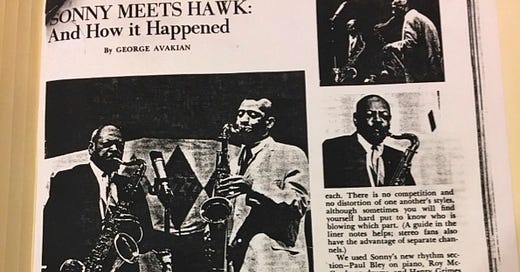(Paying Subscribers, a rare article by the producer of the album, George Avakian, is at the bottom for you.)
As you know from a previous essay, I am a big fan of the album Sonny Meets Hawk. It has a mixed reputation, but I maintained that it does have some absolutely magical moments. Last time we focused on the shortest track from the album, “Just Friends.” This time I will share with you an amazing track that didn’t make it onto the album, and that Nobody has heard before!
“Three Little Words” was a specialty of Rollins during the ‘60s. He generally played inspired solos on this old song that was written in 1930. Here, as throughout this album, he uses a highly rhythmic approach—some would say that it’s choppy, but it’s also intensely lyrical, as he tosses around melodic fragments, and I love it. This take was recorded on July 15, 1963, the first of two days of recording for the album, with Bob Cranshaw on bass, and Roy McCurdy on drums.
Here’s what you’ll hear: After the theme chorus, at 0:31, Bley drops out. (At 1:27 Sonny plays what sounds like a few notes of “There Will Never Be Another You,” another of his favorites.) At the beginning of the third chorus, at 1:32, Bley plays two chords, but Sonny vocally indicates that he doesn’t want the piano. It’s hard to hear whether Sonny just grunts, or says “stroll”—which means “don’t play”—or even says “No.” But in any case, Bley stops, and Sonny continues. As Sonny finishes, Bley comes in at 3:01 to support Hawkins.
Hawk solos. Then—this is the even more amazing part—for the rest of this track, from 4:35 on, for the next 5-plus minutes, the two masters duet. First, they trade fours (four-measure improvisations). Starting from about 6:40, Hawkins “gets” what Rollins is doing, and he plays as “way out” as Sonny does. For example, at 6:55 you would never imagine you are listening to someone born in 1904. He sounds like Archie Shepp—but actually it’s vice-versa, because Shepp was strongly influenced by Hawk. Then, from 7:30 on, Hawkins begins to play simultaneously with Rollins instead of trading. He focuses on playing isolated notes for a while, and from 8:48 to the end he repeatedly uses a saxophonist’s device to make his lowest note go a little lower—he puts his knee in the bell. I wish we had a video of this!
Meanwhile, Bley joins in at 7:38. and it seems that he’s getting signals to try and end things. At 8:34 he plays a “tag ending” (like a coda) hinting that it’s over, and there’s a voice at 8:40, which I’m guessing belongs to producer George Avakian, because everybody else is busy playing. Also, there’s a whistle during the final notes at 9:45, and one never makes a noise at the end while recording unless one has already decided that a track can’t be used. After the performance ends, there’s a few seconds of Rollins playing alone, which cuts off abruptly. Enjoy this wild and eventful ride—Here goes!:
Some people thought Sonny was making fun of Hawkins on this album, and as I explained last time, that would make no sense, because he idolized Hawk. But now I wonder, was it the other way around, on this one track? Was Hawk making fun of Sonny with all those low honks? Was he saying, “I get what you’re doing, and it’s easy—it’s just stuff like this.”
In any case, I can understand why this wasn’t included on the album, because it goes on for a long time, perhaps way past the point where it’s effective. In fact, after this take Avakian asked them to “make a good shorty” (short one). But I think it’s amazing and valuable to hear Rollins and Hawkins interact with each other like this. I hope you think so too.
All the best,
Lewis
P.S. Avakian’s archives, which include this recording and many more hours of Rollins’s RCA recordings, among other items, are now housed at the New York Public Library, Lincoln Center Branch. The catalog is here. All audio/video content is listed under Series IV. Anyone can make an appointment to study these materials. Follow the directions here to make an appointment for Special Collections. No appointment is needed for the regular collection, but this falls under Special.
(Paying Subscribers, your bonus article is below.)
Keep reading with a 7-day free trial
Subscribe to Playback with Lewis Porter! to keep reading this post and get 7 days of free access to the full post archives.


